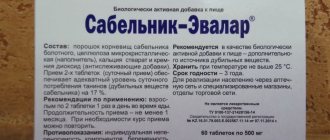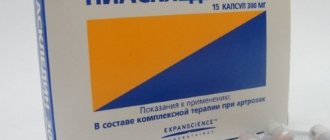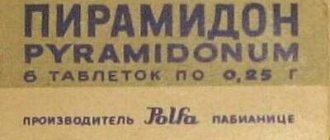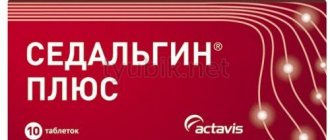The drug is directly involved in the regeneration of cartilage tissue. The components included in the composition synthesize connective tissue and prevent the destruction of cartilage. It has a clear anti-inflammatory effect, while protecting damaged cartilage from metabolic damage.
As a result of intake, a healthy cartilage matrix is formed. In addition, Theraflex promotes the formation of hyaluron, type II collagen (found in the cartilage of the knees, shoulders and other joints) and proteoglycan (highly glycosylated proteins), thereby inhibiting enzymes that tend to break down cartilage.
Pharmacology
The action of the drug is aimed at restoring cartilage tissue. The active elements take part and have a protective function in relation to damaged cartilage, preventing it from being destroyed. The components also help build cartilage and promote the production of collagen and hyaluronic acid.
The maximum concentration of active substances is observed in the liver, kidneys and joints. It stays in bone and muscle tissue for a long time. Excreted via the kidneys.
Medicine Teraflex
Teraflex is a chondroprotector drug. Chondroprotectors are medications that protect articular cartilage.
The drug is prescribed to people whose joints are undergoing or have already undergone degenerative changes as a result of frequent shock or prolonged pressure loads. The risk group includes representatives of many professions, for example, salespeople, athletes, dancers. Wear and tear of cartilage tissue is a natural process, so prevention and maintenance of joint health is always important in principle.
Chondroprotectors, in the stage of exacerbation of joint diseases, are used in combination with other painkillers, the effect of which they greatly enhance.
Composition of Teraflex
Theraflex contains two active ingredients. These are glucosamine and chondroitin sulfates. Microcrystalline cellulose with corn starch and other components that are necessary for transporting drug molecules to their destination, improving the absorption and bioavailability of the drug act as auxiliary components. It is necessary to take into account their individual tolerance in advance.
On the pharmacy shelf you can also see the drug “Teraflex Advance”. Where, in addition to the main active ingredients (glucosamine and chondroitin), the composition contains ibuprofen, a non-steroidal anti-inflammatory drug.
Thus, the combined drug Teraflex Advance is designed not only to restore and maintain cartilage tissue, but also to relieve pain and inflammation that develop against the background of lesions of the musculoskeletal system.
How to take Theraflex capsules
Adults and adolescents over 15 years of age can take 1 tablet 3 times a day. The duration of the therapeutic course is 20 days. After this, the capsules are taken 2 times a day. Such treatment can last from 3 months to six months. Depending on the condition, the course can be resumed from time to time.
Capsules can be taken at any time of the day, regardless of meal time. You need to drink a small amount of liquid.
If ointment is used, then you need to squeeze out 2-3 cm and rub into the affected area until completely absorbed. This procedure is carried out 3 times a day.
Instructions for use THERAFLEX® (THERAFLEX®)
Glucosamine
Suction
After oral administration of 14C-labeled glucosamine, it is rapidly and almost completely absorbed, with about 90% of the radioactive tracer being detected in the systemic circulation. The absolute bioavailability of glucosamine in humans after oral administration was 44%, including the first-pass effect. After daily oral administration of glucosamine at a dose of 1500 mg to healthy volunteers under fasting conditions, Cmax in plasma at steady state averaged after 3 hours (Tmax) about 1602 ± 426 ng/ml. At steady state, AUC was 14564±4138 ng×h/ml. It is unknown whether food intake has a significant effect on oral bioavailability. The pharmacokinetics of glucosamine are linear in the dose range of 750-1500 mg with deviation from linearity at a dose of 3000 mg due to lower bioavailability. There are no gender differences in the absorption and bioavailability of glucosamine. The pharmacokinetics of glucosamine were similar in healthy volunteers and patients with knee osteoarthritis.
Distribution
After oral absorption, glucosamine is distributed in various vascular compartments, incl. synovial fluid, with an apparent Vd 37 times higher than the total fluid volume in humans. Glucosamine does not bind to plasma proteins. Therefore, it is extremely unlikely that glucosamine is capable of drug interactions when taken together with other drugs that have a high degree of binding to plasma proteins.
Metabolism
The metabolic profile of glucosamine has not been studied, since being an endogenous substance, it is used as a “building material” for the biosynthesis of articular components of cartilage. Glucosamine is primarily metabolized by conversion to hexosamine, independent of the cytochrome system. Does not act as an inhibitor or inducer of human CYP450 isoenzymes, including CYP3A4, 1A2, 2E1, 2C9 and 2D6.00. There were no clinically significant interactions between glucosamine and other drugs that could occur through inhibition and/or induction of human CYP450 isoforms.
Removal
In humans, T1/2 of glucosamine from plasma is 15 hours. After oral administration of 14C-labeled glucosamine, excretion in urine was 10±9%, in feces - 11.3±0.1% of the administered dose. The average excretion of unchanged glucosamine after oral administration in humans is approximately 1% of the administered dose, suggesting that the kidney and liver do not play a significant role in the elimination of glucosamine, its metabolites and/or its degradation products.
Pharmacokinetics in special groups of patients
Pharmacokinetic studies of glucosamine have not been conducted in patients with renal or hepatic impairment. These studies were considered inappropriate due to the insignificant contribution of the liver and kidneys to the metabolism, degradation and excretion of glucosamine. Therefore, given the favorable safety profile and good tolerability of glucosamine, dosage adjustment of the drug is not required in patients with renal or hepatic impairment.
The pharmacokinetics of glucosamine have not been studied in children and adolescents.
Pharmacokinetic studies have not been conducted in elderly patients, however, clinical trials of the effectiveness and safety of glucosamine included mainly elderly patients. It has been shown that there is no need for dose adjustment in this category of patients.
Chondroitin sulfate
Pharmacokinetics have not been studied.
Contraindications
The instructions contain a list of conditions and diseases for which taking the drug is contraindicated. These include:
- kidney diseases;
- bearing a child;
- breastfeeding period;
- allergic reaction to the constituent components;
- persons under 15 years of age;
- skin damage (for the drug in the form of an ointment).
It should be taken with extreme caution if you have bronchial asthma or high blood sugar levels. You also need to be careful if you are prone to bleeding.
Form of release of the medicine and order of administration
The release form of Teraflex Advance is tablets or hard opaque gelatin capsules, which consist of a white body and a blue cap. The capsules also have the inscription “TERAFLEX ADVANCE” in blue. The capsules contain a heterogeneous white powder. Available in bottles of 30, 60 and 120 capsules.
One capsule of the drug contains 250 mg of glucosamine sulfate, 200 mg of sodium chondroitin sulfate, 100 mg of ibuprofen, as well as a number of excipients (cellulose, pregelatinized and corn starch, stearic acid, crospovidone, sodium carboxymethyl starch, magnesium stearate, silicon dioxide and povidone).
It should be noted that tablets are taken in this way, Teraflex ointment is used somewhat differently, it has its own instructions for use.
Adverse reactions and overdose
When taken orally, the patient may in rare cases experience undesirable reactions:
- pain in the abdominal area;
- stomach upset;
- constipation;
- disturbed sleep;
- dizziness;
- drowsiness, fatigue;
- headache;
- abnormal heart rhythm;
- swelling of the legs;
- allergic reactions.
If we talk about ointments, the only undesirable manifestation may be allergic reactions in the form of a skin rash.
No cases of overdose have been identified to date. If any undesirable reactions occur, you need to rinse your stomach.
Are there analogues
Based on the action of “Teraflex”, it is possible to determine what analogues of this medicine exist. In fact, the modern pharmaceutical market offers many substitutes for this drug. However, not all of them are effective. Under no circumstances should you chase cheap tablets and ointments, as their composition will be very dubious
Most often, doctors recommend their patients to pay attention to joint medications such as:
- "Arthrocin";
- "Doppelherz Glucosamine + Chondroitin";
- "Arthra";
- "Kondronova".
All of the drugs listed above are available in the form of tablets intended for oral administration.
Pay also attention to the ointment “Sustavit”. It has a similar composition and has a similar effect on the body.
Do not self-medicate under any circumstances. Start taking medications to treat joints only after they have been prescribed to you by your doctor; do not risk your health. Analogues of Teraflex tablets exist, and in huge quantities, but it is recommended to buy them only after visiting an experienced specialist.
Reviews of Terfalex
Of the numerous reviews, most are positive. Patients are assured that the money spent is worth it and the drug really has the desired effect. After completing the treatment course, many people note that pain and crunching in the joints have disappeared, and mobility has increased. But even with such results, for some, the price of the drug is a significant disadvantage.
In general, it can be argued that with long-term therapy, tremendous results can be achieved. In this case, the patient should not have an advanced stage of the disease, and the course of treatment should last at least half a year. For many, a significant advantage is that Theraflex can be combined with anti-inflammatory drugs and other treatments.
What effect does the drug have on the body?
Teraflex tablets stimulate the regeneration of cartilage tissue in a natural way. In addition, they have another very important property - they increase the amount of joint fluid produced, the main function of which is to significantly reduce friction between the joints. An insufficient amount of it can lead to joints wearing out very quickly.
A sufficient amount of joint fluid will also significantly reduce pain. And this will significantly improve a person’s quality of life and make it much more comfortable.
Regular use of Teraflex tablets will significantly reduce the use of anti-inflammatory drugs, and in some cases eliminate their use altogether.
Side effects
Capsules have an impressive list of adverse reactions.
Patients often experience flatulence, gastralgic pain, diarrhea, nausea and vomiting, constipation, and various allergic manifestations. The vast majority of side effects are caused by the presence of ibuprofen. When you stop taking it, all side symptoms go away on their own.
Possible adverse reactions can affect almost any system of the body:
- Heart, blood vessels - pressure increases, heartbeat increases, myocardial failure may develop;
- Hematopoiesis - the occurrence of a predisposition to bleeding, anemia, thrombocytopenia (pathologically low platelet count), bleeding and subcutaneous hemorrhages that occur against the background of low platelet levels;
- Respiratory system – shortness of breath and bronchospasms;
- Urinary excretion - cystitis, nephritis, acute kidney failure, nephrotic syndrome (severe swelling and an increase in the amount of fat and protein in the urine, excessive blood clotting);
- Nervous system abnormalities - headaches and sleep disorders, dizziness and irritability, depression and drowsiness, confusion and hallucinogenic manifestations;
- Digestion - gastralgic pain or dry mouth, nausea and vomiting or heartburn, stomatitis, diarrhea or constipation, bloating, hepatitis, pancreatitis;
- Allergic symptoms - itching, multiple rashes, urticaria, bronchospasms or Quincke's edema, anaphylactic shock or allergic rhinitis, pustular rashes, Lyell's syndrome (an acute process of necrosis of skin and mucous tissues, accompanied by numerous toxic lesions of internal organs);
- Sense organs – double and dry eyes, conjunctivitis or swelling of the eyelids, auditory disorders such as poor hearing or extraneous noise in the ears.
How it works
The action of the capsules is combined and is determined by the main active ingredients: chondroitin, glucosamine and ibuprofen.
- Glucosamine has a beneficial effect on the synthesis of the main cartilaginous components (hyaluronic acid, proteoglycans, etc.), intra-articular fluid and joint membranes;
- Chondroitin promotes the rapid formation of new cartilage tissue, blocks the formation of enzyme substances that destroy cartilage, reduces the intensity of clinical manifestations, and allows you to reduce the dosage of non-steroidal drugs used. In addition, this component returns the joints to their former mobility and protects them from destruction;
- Ibuprofen, an anti-inflammatory drug, can relieve pain and has antipyretic properties. And the complex chondroitin-glucosamine effect helps to increase the analgesic effect.
Due to the presence of an anti-inflammatory non-steroidal substance, the capsules provide rapid relief from pain. The analgesic effect occurs almost immediately after taking the medicine. Although there is also a negative aspect to this.
Chondroprotectors must be used for a long time, since they begin to have a therapeutic effect only when they accumulate in the body in the required concentration.
conclusions
Take care of yourself now
Pay attention to your lifestyle and diet. Most likely, your musculoskeletal system simply lacks the necessary microelements
The drug "Teraflex" contains many elements necessary for joints, restoring damaged tissue, and also increasing the amount of necessary joint fluid.
Don't forget about your health. Take care and love yourself, and then your body will begin to take care of you. Start eating right, exercise, walk more in the fresh air and take full responsibility for your health, and then you will not have problems with it.
A few words about the composition and form of release
The instructions describe the drug "Teraflex" as a very effective remedy. This is a chondroprotector. So, the main active ingredients of this medicine are chondroitin sulfate and glucosamine hydrochloride. The composition also includes additional components that allow the product to be better absorbed and also give it the necessary shape. Auxiliary components include magnesium stearate, stearic acid and manganese sulfate.
The drug is available in the form of capsules and also as an ointment for external use. Each capsule has a gelatin shell containing white active powder.
The capsules are placed in a plastic bottle that can hold thirty, sixty or one hundred twenty capsules. It, in turn, is placed in a cardboard package, in which you can also find instructions for Teraflex.
The drug is also available in the form of an ointment intended for external use. It is usually prescribed by doctors to their patients to enhance the effect of treatment with pills. You can buy this product at any pharmacy without having a prescription from your doctor. However, it is still strongly recommended not to self-medicate and consult a specialist before taking the drug.




